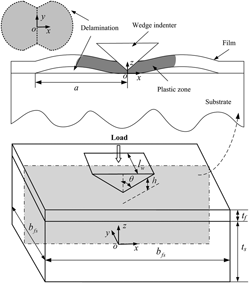Article contents
A new approach to determine wedge-indented interfacial toughness in soft-film hard-substrate systems with application to low-k films on Si substrate
Published online by Cambridge University Press: 17 October 2012
Abstract

A new approach has been proposed to determine the interfacial toughness of soft-film hard-substrate systems based on wedge indentation experiments. In this approach, a comprehensive finite element study was undertaken to correct de Boer’s solutions, which were used to measure the wedge-indented interfacial toughness. Two-dimensional indentation simulations were first performed to systematically study the effects of the plastic properties of the films and the interfacial toughness itself on the correction factor for de Boer’s equations, which were used as closed-form solutions to evaluate the interfacial toughness. Further, three-dimensional simulations were used to investigate the effects of stress states on the interfacial toughness, which depends on the ratio of the indenter length to the film thickness. A universal correction expression for de Boer’s equations was obtained using a regression method. With this expression, a reverse algorithm was proposed to determine the interfacial toughness, and extensive numerical calculations were performed to verify that the present approach accurately evaluates the interfacial toughness. Finally, this new approach was applied to analyze the wedge indentation of low-k dielectric films, namely, methylsilsesquioxane and black diamond (BDTM) films, on a Si substrate.
Keywords
- Type
- Articles
- Information
- Copyright
- Copyright © Materials Research Society 2012
References
REFERENCES
- 1
- Cited by


